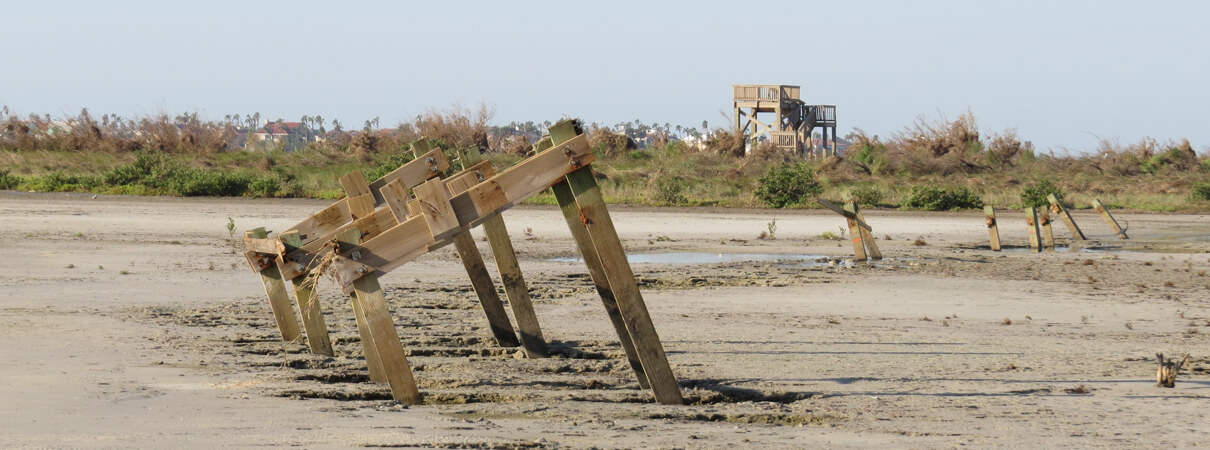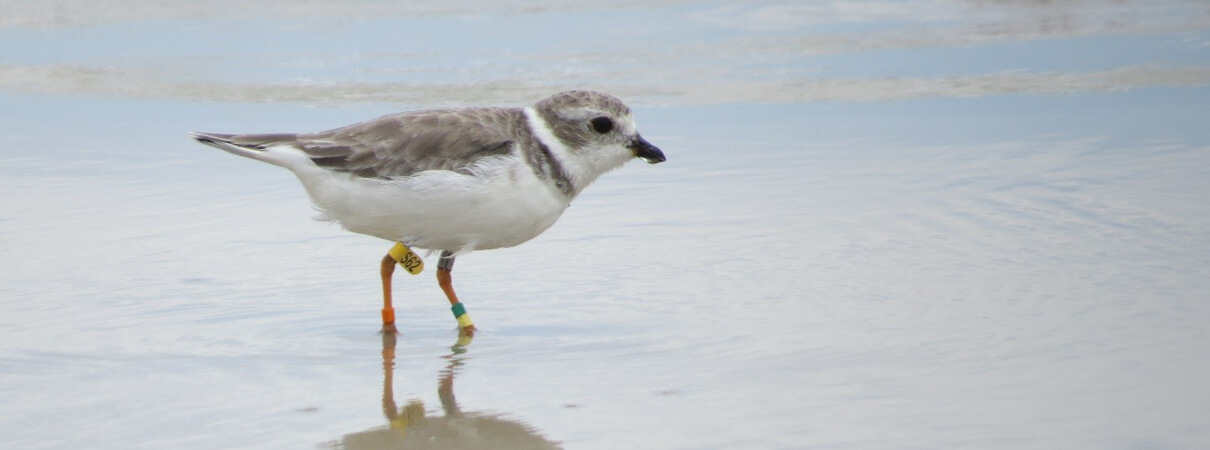After Harvey, Plovers Persist at Texas Beaches
Editor's note: The Port Aransas Nature Preserve in Texas is one of the sites where ABC monitors Piper Plovers and other beach-nesting birds. Nearby Aransas National Wildlife Refuge is a major wintering spot for endangered Whooping Cranes. Hurricane Harvey struck the Port Aransas Nature Preserve at a category-4 level. We asked Kristen Vale, ABC's Texas-based Gulf Coast Coordinator, to give us an update on the destruction caused by the storm at the preserve and at Mustang Island, another site where ABC conducts Piping Plover surveys. She shared some field observations from ABC contractor Kristina Macaulay, who works alongside the Coastal Bend Bays & Estuaries Program (CBBEP). Here's their report. We will be sharing more news and updates from areas affected by Hurricane Harvey and Hurricane Irma as we get them.
At Port Aransas, we've seen a lot of infrastructure loss. The road leading to the preserve was severely damaged, and the boardwalk that runs through it was completely destroyed during the storm. Very few remnants from the boardwalk remain. Storm waters forged several new channels that can be seen in before-and-after satellite imagery.

Hurricane Harvey destroyed the boardwalk at Port Aransas Nature Preserve. Photo by Kristina Macaulay
The loss of the boardwalk could negatively impact the birds in several ways. Before it was built, people were permitted to walk and drive through the habitat, which posed substantial risk to the nesting birds. Once the boardwalk was in place, it kept visitors on a designated pedestrian path, and people were no longer permitted to drive there. As a result, the boardwalk improved the habitat quality for beach-nesting and ground-nesting bird species, as well as for the birds that use that site year-round for foraging and roosting. ABC, our partners, and local stakeholders will be exploring ways to rebuild this infrastructure so this important site can continue to receive the protections the boardwalk provided.
We've also seen a number of changes in the habitat available to the birds that use the area, including several species of plover. Post-Harvey, the beaches are now almost completely flat sand, which has covered the short intertidal vegetation often used by beach-nesting birds, especially Wilson's Plovers and Snowy Plovers, as camouflage for their nest or chicks.
How long the vegetation takes to regrow may temporarily limit the number of birds that can safely nest within the habitat. However, species such as Least Terns prefer bare sand and may even benefit from the change in habitat, with potentially growing numbers choosing to nest in the area next year.
Mustang Island State Park, southwest of Port Aransas, also received significant damage. Park management has speculated that the park will be closed until a new bathhouse is constructed, which could take a year or more. They hope this is the worst-case scenario and that some interim solution can be found.
Along the beaches of Mustang Island, an increase in trash and debris is one of the most noticeable changes observed since Harvey hit. The shorebird roosting habitat commonly used by Piping Plovers, Snowy Plovers, and Sanderlings near the Newport Pass Road beach entrance was washed over by storm surge. That reduced the dunes, resulting in a much flatter habitat since the storm. The good news is that this should not have a long-term impact on the birds' roosting habitat.

A banded Piping Plover forages on the beach after Hurricane Harvey. Photo by Kristina Macaulay
In more good news, early surveys suggest that several species of plover that migrate through or breed and winter in the area survived the storm. Since Harvey came through, Piping Plovers, Snowy Plovers, and Wilson's Plovers have all been observed using the beaches to roost and forage. Accessible areas on the beach have been surveyed. Though it's hard to know if any birds were lost from the hurricane, it is encouraging to see comparable numbers of focal species in our initial beach surveys compared to last year's surveys.
In regards to the surveyed beach and bayside habitat, we're relieved that more habitat was not severely damaged by Hurricane Harvey. Mustang Island has a tall and mature dune system that most likely helped protect the back-beach habitats. Though there was some structural damage within our monitoring sites and to the surrounding communities, the habitat too will slowly recover from this powerful storm.
Fortunately, the coastal ecosystem is dynamic in nature, and such storms are part of the cycle that keeps these habitats healthy and available to a variety of migrating, breeding, and wintering coastal birds.
Learn more about ABC's work with Gulf Coast birds here.


















































